Tiny Epic Galaxies - A Review
(of the prototype)
Thanks to a bit of luck (my name got pulled from a raffle), I was recently afforded the opportunity to play a prototype of the board game Tiny Epic Galaxies (TEG) - BGG Page. Having never played an unreleased game before [save the print-and-play offerings from various Kickstarter campaigns], I was intrigued to give it a try. After playing numerous rounds with friends and family, what I found was a fairly well balanced game, with equally well developed instructions, that was in turns fun to play and enigmatic.
What is it?
Tiny Epic Galaxies is a 2-4 player light strategy / galaxy building game created by Scott Almes and published by Gamelyn Games. This is the 3rd installment in the 'Tiny Epic' series, preceeded by Tiny Epic Kingdoms and Tiny Epic Defenders. All three games are intended to be 'Micro Games', delivered in small (5x7x1-ish) boxes and playable in 30 minutes or less. TEG departs from the setting/story line of the previous two games, bringing the story to 'space' in the hopes of pulling you into a contest for galactic domination.
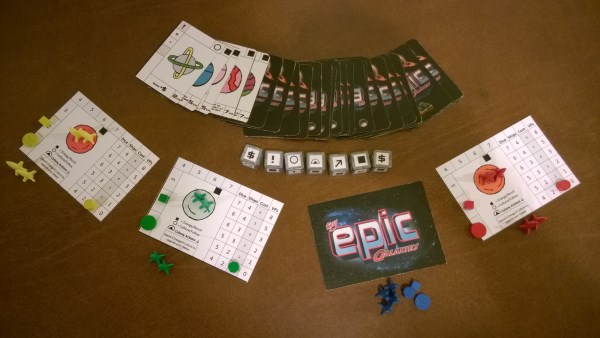 Tiny Epic Galaxies
Tiny Epic GalaxiesGame (Prototype) Contents
How does it work?
The game is played in rounds, with the level of the players' Galaxy determining how many ships they have in play, how many dice they roll and how many victory points their galaxy affords them. Each player takes a turn by rolling the dice and 'locking in' actions. Other players, who have culture points remaining, can piggy-back off the current player's last move by spending one of their culture points to duplicate the last locked action. Players move to and persuade planets to join their Galaxy, gaining victory points and powers they can use with the appropriate dice roll. Once a player reaches 21 combined victory points [from captured planets and the players' Galaxy], all other players have a single turn to match or exceed the winning player's victory point total. In the end, the player with the most victory points has won the 'Quest for Galactic Domination'.
Game Setup
Setting things up for a game is pretty straightforward, just give each player the following components:
- A Galaxy card
- Set of 4 ships
- A cube marker [energy]
- A disc marker [culture]
- A hex cylinder [galaxy level]
Players start with their 'base' Galaxy - A home planet with 2 ships, 2 energy and 1 culture. The remaining two ships are placed in reserve, for use after the Galaxy has been upgraded. The 30 planet cards are then shuffled and the number of players + 2 planets are dealt face-up in the center, with the others held face-down in reserve to be used during play.
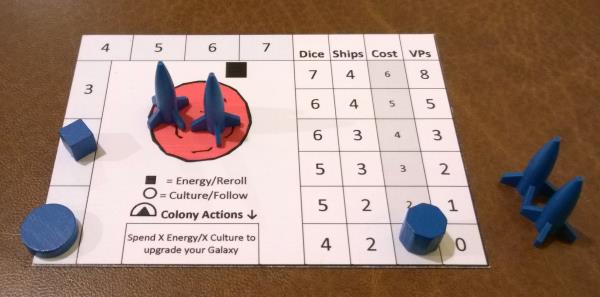 Starting Galaxy Setup
Starting Galaxy SetupStarting Galaxy Setup
Gameplay
Play then proceeds by selecting a starting player. The instructions suggest the last person to finish a sci-fi novel, but we just chose at random [or the youngest player when playing with my kids]. The base Galaxy affords the players 4 dice to roll, so player one kicks things off by rolling their four dice and deciding which to keep and which to re-roll. One re-roll is free, and all additional re-rolls consume one energy.
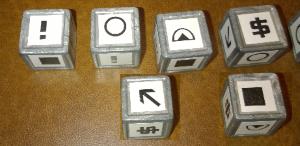 The Dice
The DiceThe Dice
There are 6 possible actions for each die [pictured above]. Actions include basic movement, energy/culture capture, colonization
and 'Galaxy action' [officially a 'Colony Action']. As each die is 'locked' the current player performs that action and sets that die aside.
Then any player who has culture points remaining can choose to duplicate the just-locked action by spending one culture point. That player then
immediately takes that action, before the current player can proceed with their next action. If more than one out-of-turn player wants to act,
actions are performed in turn-order.
The remaining dice are then locked, one at a time, with the current player choosing to use their re-roll(s) at any point during their turn.
If a planned action is nullified by another person's out-of-turn action, the player can use their free re-roll [or spend energy if available] to 'replan'
on the fly. Once the player has activated all the dice they plan to use, play proceeds clockwise around the table. The current player
does not need to use all their rolled dice, and any dice which are not activated cannot be duplicated by other players.
The Planets
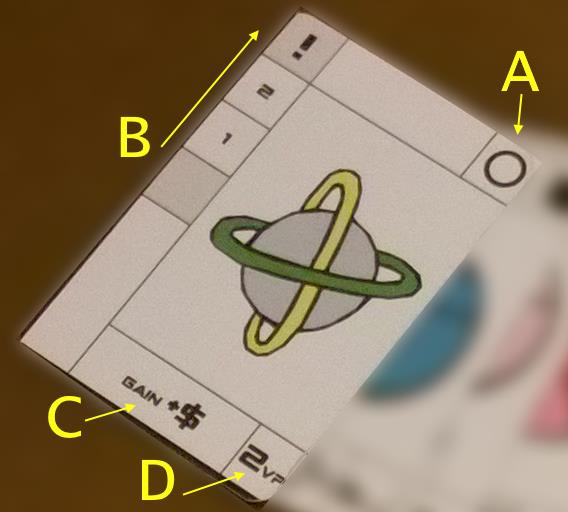 A Planet
A PlanetA Planet Card
Each planet arrayed in the center of the table has 4 basic components:
- A - Resource [energy or culture]
- B - 'Colonization' Track [$ or !]
- C - Power / Action
- D - Victory Points
Movement and Colonization
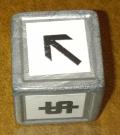 Move Die
Move DieUsing a move action die allows a player to move their ship to any planet card that does not currently host one of their ships. Each planet card has two possible landing sites. The first landing site is the planet's surface, which can be occupied by only a single ship. Landing here activates that planet's "power" immediately. The second possible landing site is the start of the 'colonization' track. Any number of players can be vying for colonization of the planet at the same time. When moving a ship that currently resides on a planet card, the player must move their ship OFF the current card. Ships cannot be moved between the colonization track and planet surface without first leaving the planet. The only card which may house more than one ship / player is the player's Galaxy card. Ships that have been displaced, or which move newly into service are placed on the home planet.
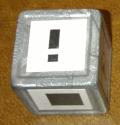 Diplomacy Die
Diplomacy Die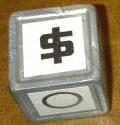 Invest Die
Invest DieUsing a colonizing action [$ or !] allows the player to move one of their ships on a matching planet up one 'space' on the colonizing track, towards the colonization symbol. When the symbol at the end of the track is reached, that planet is claimed by the player and becomes part of their Galaxy. Once colonized the planet loses its resource generating ability, but the colonizing player gains both the victory points and planet "power" to use as a 'Galaxy'/'Colony' action. All ships currently occupying the planet card are immediately returned to their home planet.
Resource Gathering
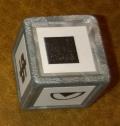 Energy Die
Energy Die Culture Die
Culture DieWhen activating an energy or culture die, players initiate a 'resource gathering' action. Each planet card that provides the activated resource and currently hosts a player's ship supplies one 'point' of that resource to the player's reserves. NOTE: This includes the player's home planet if the activated resource is energy. Energy and Culture reserves have a maximum capacity of seven (7). Once the reserves are full, furthur gathering of that resource has no effect.
Galaxy [or Colony] Actions
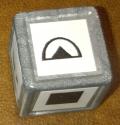 Colony Die
Colony DieThe final die face is the 'Galaxy' or 'Colony' action. Initially this action can only be used to 'upgrade' the Galaxy, providing more dice / turn or more ships to deploy. When upgrading the Galaxy, the associated victory points and any additional ships are activated immediately, but new dice do not come into play until the player's next turn. If additional planets have been pulled into the Galaxy, a single planet's power can be choosen instead of the base action. Planetary actions range from purely selfish [+1 culture/energy, combined energy+culture upgrades] to mildy disruptive [steal a culture/energy, move enemy ships down the colonizing track] all the way to devious [move ships to other planets, re-roll unactivated dice]. Planetary actions always override the base game rules/flow, and can be leveraged to great effect by saavy players.
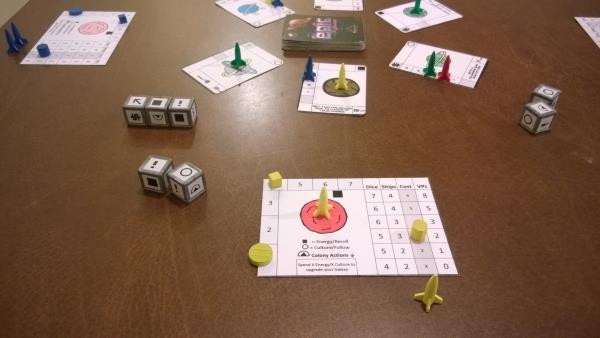 Game In Progress
Game In ProgressGame in Progress
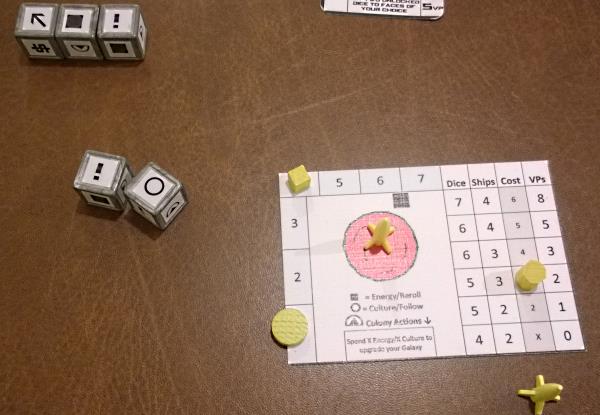 Player Galaxy
Player GalaxyPlayer Card
Experience / Impressions
I had an opportunity to play the prototype with multiple groups of family and friends over the last few weeks, and the overall feeling was pretty well spread across the board. It feels rather clear to me that board gaming experience matters. Those who played games often seemed to pick up Galaxies more quickly, while those who didn't game often were more likely to get 'bogged down' in all the rules and potential strategies. The game also benefits from multiple playthroughs. I know I didn't feel entirely comfortable with the rules and strategy until my third game, and I lost a few players midway through their first game due to the perceived complexity.
While a majority of the people I played with were adults, I ended up playing the game most often with my two elementary / middle school aged sons. I would feel safe recommending this game even to elementary school children [say, 7yr+], especially if the children have shown an aptitude for strategy and are interested in board games. After a few rounds, even my youngest son was able to negotiate a reasonable strategy and be somewhat competitive. Middle school aged kids [10yr+] should have no problems picking up the game, IF you can convince them to sit down for a family game night :).
As I mentioned initially, the rules are fairly well written for a prototype. I missed the ability to land on the planet's surface
on our first play through, and didn't remember we could re-roll using energy until the middle of the second game. Games, especially with
new players, tended to start out pretty slowly. However, once most players understood the rules, play cadence picked up significantly.
While we were never able to get a 4-player game completed in 30 minutes, we were able to keep it under an hour most times. The average play
time for our groups was around 45 minutes, and it seemed like the 'sweet spot' was 3 players. Two player games were fun, but the game really
opened up once you hit the third player. Four players was equally fun, but the game seemed to get a little more drawn out, and was hard to
keep inside the 60 minute window that most of my play sessions had.
Given that this is the third installment in the 'Tiny Epic' series of games, it seems appropriate to compare/contrast this game with the other games in the series. Having backed the Kickstarter for Tiny Epic Defenders, I had a copy of the print-and-play, and have played with many of the same groups where I prototype'd Galaxies. Interestingly enough, it was a pretty even split between the two groups as to which of the two games was preferred. It feels like the 'hook' for Defenders is a bit stronger within my play circles, although I personally prefer Galaxies. While I don't feel that the rule sets between the two games are much different from a complexity standpoint, friends and family consistently rated Galaxies as 'harder to understand', even if they liked it as much or better than Defenders. It may be due to the competitive nature of Galaxies vs. Defenders co-op play which encourages sharing of strategies/suggestions. While I also own Tiny Epic Kingdoms, I have not yet had a chance to play it (it's a Christmas gift for the kids), so I can't make any personal comparisons there.
Clarifications / House Rule Suggestions
As this is a prototype, rule clarifications were to be expected. Gamelyn Games staff were very responsive to Twitter questions, and we were able to get a few questions cleared up pretty quickly. Of course, I didn't always like the answers :)
- Colonized planets are officially replaced at the end of each round. However, in our play sessions, we found that following this rule caused a pretty heavy 'last player handicap' and that play moved much more smoothly [and fairly] if colonized planets were replaced immediately.
- The rules are unclear about how many players can occupy the planet's surface, but based on the explicit call-out of multiple colonizing players, we chose to limit the planet surface to a single ship.
- Planet powers/actions generally override any normal game rule, but some planet rules are somewhat confusing. We usually just decided what the power 'meant' when the planet joined the center of the table, and could usually come to a reasonable consensus quickly.
- Replacing colonized planets immediately helped even out the overall game, but it feels like adding +1 [culture OR energy] by player position would help to further balance play. In this way later players get more opportunity to use previous player actions. I haven't played enough rounds with this rule to tell whether it unbalances the game, but it feels like a good fit thus far.
Conclusion
Overall I was very pleased with the play experience of Tiny Epic Galaxies. The strong blend of luck and strategy combined with relatively quick pacing means that this game will have a place on my game shelf for a long time to come. There is enough of a hook to pull players in, and once the rules are well understood, the game plays quickly. Replayability is high, and the game felt a bit different each time we played. Strategies that worked in previous games were easily countered or non-functional in future games due to the mix of planets and luck of the dice roll.
The Good
- Quick, Light Strategy Game with just enough luck thrown in to keep you guessing
- Multitude of different strategies possible, no 'one sure way to win'
- Accessible to kids [10+ for sure, 7+ is possible]
- 45-60 minute play times [with 4 players]
The Bad
- Some planets actions are unclear
- How you'll feel if you miss out on the Kickstarter [starts Jan 8th, 2015]
The Ugly
- It's not available for Christmas 2014